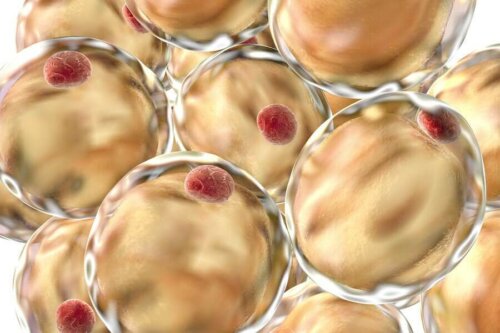White, Beige, and Brown Types of Body Fat


Written and verified by Nursing Daniel Baldó Vela
Did you know there are different types of body fat?
In fact, the body has white, beige, and brown adipocytes, or fat cells. Thus, this substance is either healthy or unhealthy depending on its color.
Types of body fat
White body fat
The white body fat is the one most people are familiar with, that is, the one that accumulates. It’s an energy reserve and its metabolic impact is responsible for all the pathogenesis associated with obesity.
Unfortunately, it’s the most abundant type of fat in the human body and obese people have it in large amounts.
Find out what are The Benefits of Lypo-Contrast Against Fat
Brown fat

This type of body fat is thermogenic; that is, it activates the metabolism to obtain energy in the form of heat. In fact, its dark color is due to its high density of mitochondria (energy unit of the cells).
The activation of brown adipocytes increases the oxidation of fatty acids (lipolysis).
Until a few years ago, people believed that this type of body fat was only present in newborns so they could maintain an optimal temperature after its appearance in the external environment.
However, today we know it’s also present in adults and there’s more of it in thinner people, although in a smaller proportion. At least according to a study published in the Current Opinion in Lipidology magazine.
People with obesity have a lower amount of brown adipocytes.
The location of this kind of fat in newborns is in the interscapular region and can represent up to 5% of total body weight. It’s dispersed among the white adipocytes in adults, mainly in the neck, supraclavicular region, periaortic tissue, paravertebral region, and perirenal zone.
Beige body fat
The discovery of beige fat is quite recent. These are white adipocytes that behave like brown ones by the action of certain stimuli that activate the secretion of irisin. The white adipocytes recover their original behavior when the stimulus goes away.
Irisin is a hormone that turn white fat into brown.
Furthermore, this type of fat decreases with age according to an article published in the Frontiers in Endocrinology journal.
Now you know which types of body fat are the healthiest. Based on it, your new goal should be to increase the number of brown adipocytes and maximize the conversion of white fat to beige. So let’s get into the kind of stimuli you need to accomplish it.
Stimuli that favor the browning of white fat

Colder temperatures and physical exercise are the only two stimuli capable of activating brown fat and making white fat behave as such momentarily. Thus, these are key to the management of obesity and its complications.
Current research continues to look for ways to brown the white fat and to maximize its effect.
This is particularly important in cases of hyperplastic obesity due to an increase in the number of adipocytes. Currently, the different ways of dealing with overweight only allow a reduction in the size of the adipocytes and not their number.
Thus, people who became obese during childhood (hyperplastic obesity) will always maintain a greater obesogenic tendency than those who became obese later on (hypertrophic). So the key here is to make them behave differently as we cannot eliminate the adipocytes.
Cold temperatures against obesity
So far, exposure to cold is the most powerful and effective stimulus to activate brown fat and make white adipocytes behave like brown ones. However, there are no known exposure strategies yet that are effective and not damaging.
Researchers continue to search for effective strategies that don’t involve long periods of cold exposure.
The impact of physical exercise on body fat
This is further evidence of the benefits of physical activity; these go beyond caloric expenditure. We know it can stimulate brown tissue and make the target behave like it momentarily.
Furthermore, it can modify the obesogenic epigenetics.
There are different types of fat
Scientists revealed there are three different types of body fat. However, we don’t know exactly how to stimulate the increase of deposits of healthy fats yet.
Thus, there’s still research to conduct. Stay tuned!
All cited sources were thoroughly reviewed by our team to ensure their quality, reliability, currency, and validity. The bibliography of this article was considered reliable and of academic or scientific accuracy.
- Heeren J., Scheja L., Brown adipose tissue and lipid metabolism. Curr Opin Lipidol, 2018. 29 (3): 180-185.
- Zoico E., Rubele S., De Caro A., Nori N., et al., Brown and beige adipose tissue and aging. Front Endocrinol, 2019.
This text is provided for informational purposes only and does not replace consultation with a professional. If in doubt, consult your specialist.








